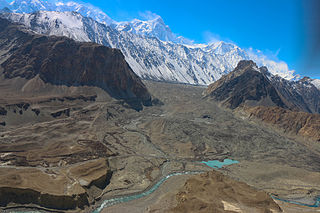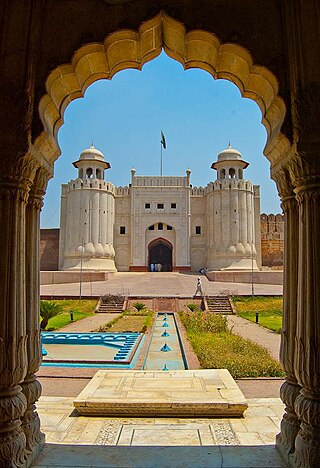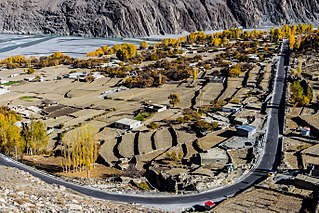
Gojal, also called Upper Hunza, is situated in northwestern Pakistan. It borders China at the Khunjerab Pass, and Afghanistan at the Chapursan valley. In 2019, Gojal Valley became the second Karachukar sub-division within the Hunza District. It is geographically the largest subdivision of Gilgit-Baltistan.

Hunza River is the principal river within the Hunza region in Gilgit–Baltistan, Pakistan. It is formed by the confluence of the Chapursan and Khunjerab nalas (gorges) which are fed by glaciers. It is also joined by the Gilgit River and the Naltar River, before it flows into the Indus River.

The Karakoram Highway is a 1,300 km (810 mi) national highway which extends from Hasan Abdal in the Punjab province of Pakistan to the Khunjerab Pass in Gilgit-Baltistan, where it crosses into China and becomes China National Highway 314. The highway connects the Pakistani provinces of Punjab and Khyber Pakhtunkhwa plus Gilgit-Baltistan with China's Xinjiang Uyghur Autonomous Region. The highway is a popular tourist attraction and is one of the highest paved roads in the world, passing through the Karakoram mountain range, at 36°51′00″N75°25′40″E at maximum elevation of 4,714 m (15,466 ft) near Khunjerab Pass. Due to its high elevation and the difficult conditions under which it was constructed, it is often referred to as the Eighth Wonder of the World. The highway is also a part of the Asian Highway AH4.

Skardu is a city located in Pakistan-administered Gilgit-Baltistan in the disputed Kashmir region. Skardu serves as the capital of Skardu District and the Baltistan Division. It is situated at an average elevation of nearly 2,500 metres above sea level in the Skardu Valley, at the confluence of the Indus and Shigar rivers. The city is an important gateway to the eight-thousanders of the nearby Karakoram mountain range. The Indus River running through the region separates the Karakoram from the Ladakh Range.

The Gilgit Agency was an agency within the British Indian Empire. It encompassed the subsidiary states of the princely state of Jammu and Kashmir situated along the northern border. The primary objective of establishing the Gilgit Agency was to bolster and fortify these regions, particularly in the context of concerns about Russian encroachment in the area. The subsidiary states encompassed Hunza, Nagar and other states in the present day districts of Gupis-Yasin, Ghizer, Darel, Tangir and Diamer. The agency headquarters was based in the town of Gilgit, within the Gilgit tehsil of Jammu and Kashmir.

Northern Pakistan is a tourism region in northern and north-western parts of Pakistan, comprising the administrative units of Gilgit-Baltistan, Azad Kashmir, Khyber Pakhtunkhwa, Islamabad Capital Territory and the Rawalpindi Division in Punjab. The first two territories are a part of the wider Kashmir region. It is a mountainous region straddling the Himalayas, Karakoram and the Hindu Kush mountain ranges, containing many of the highest peaks in the world and some of the longest glaciers outside polar regions. Northern Pakistan accounts for a high level of Pakistan's tourism industry.

The Hunza Valley is a mountainous valley in the northern part of the Gilgit-Baltistan region of Pakistan.

Pakistan Tourism Development Corporation is an organization of the Government of Pakistan. PTDC is governed by the Board of Directors and provides transportation to various areas and owns and runs several motels across the country. It was incorporated on 30 March 1970.

Nagarkhas, also known as Oyum-Nagar, serves as the administrative center for the Nagar District in Gilgit–Baltistan region of Pakistan and is one of the main towns of the district. Located along the Nagar River, this town also held the distinction of being the capital of the erstwhile princely state of Nagar.

Gilgit-Baltistan is an administrative territory of Pakistan in the northern part of the country. It was given self-governing status on August 29, 2009. Gilgit-Baltistan comprises 14 districts within three divisions. The four districts of Skardu Kharmang Shigar and Ghanche are in the Baltistan Division, four districts of Gilgit Ghizer Hunza and Nagar districts which were carved out of Gilgit District are in the Gilgit Division and the third division is Diamir, comprising Chilas and Astore. The main political centres are the towns of Gilgit and Skardu.

The Rupal Valley is a valley located in the Astore District of Gilgit-Baltistan region in Pakistan. It lies on the southern side of Nanga Parbat, and is accessed via the Astore Valley, which leaves the Karakoram Highway at Juglot, some 60 kilometres south of Gilgit.

Tourism in Pakistan is a growing industry. In 2010, Lonely Planet termed Pakistan "tourism's 'next big thing'". The country is geographically and ethnically diverse, and has a number of historical and cultural heritage sites. Condé Nast Traveller ranked Pakistan The Best Holiday Destination for 2020 and also declared it the third-highest potential adventure destination in the world for 2020. As security in the country improves, tourism increases; in two years, it has increased by more than 300%. The Pakistani government had launched online visa services for 175 countries and 50 countries were offered visa on arrival, making visiting Pakistan easier. The country received an influx of travel vloggers, who promoted the characteristics of the country, such as in the Northern Pakistan, like Hunza and Skardu.

Gilgit-Baltistan, formerly known as the Northern Areas, is a region administered by Pakistan as an administrative territory and consists of the northern portion of the larger Kashmir region, which has been the subject of a dispute between India and Pakistan since 1947 and between India and China since 1959. It borders Azad Kashmir to the south, the province of Khyber Pakhtunkhwa to the west, the Wakhan Corridor of Afghanistan to the north, the Xinjiang region of China to the east and northeast, and the Indian-administered union territories of Jammu and Kashmir and Ladakh to the southeast.

Aliabad is the administrative and commercial center of the Hunza District in Gilgit–Baltistan region of Pakistan.
Khizerabad is the first village in Hunza District of Gilgit-Baltistan, Pakistan.
Jafarabad is a town located in the Nagar District of Gilgit-Baltistan, Pakistan.

Safar Hai Shart is a travelogue television show on-air on Express News. The show was hosted by Waqar Ahmed Malik and Mukkaram Kaleem. Safar Hai Shart was an exclusive travelogue produced by Waqar Ahmed Malik, completed on nothing but motorbikes. Two guys on bikes explored the wonders of the Karakoram Highway in Pakistan. The Karakoram Highway (KKH) is the highest paved international road in the world and often known as 9th wonder of the world. The travels started from Rawalpindi and end on Khunjerab Pass, the highest paved international border crossing in the world and the highest point on the Karakoram Highway. The show comprises the adventure, thrill and depiction of native culture of Kohistan, Gilgit and Hunza. Safar Hai Shart also showed Nanga Parbat and the related expedition stories specially of Hermann Buhl, Reinhold Messner in 6th and 7th episodes. This program was produced with the cooperation of Frontier Works Organisation and World Wide Fund for Nature.

Mayoon or Maiun is a village and a small region of modern farms in the high mountainous Hunza area of northern Pakistan. It lies along one of the paths of the ancient Silk Road and has long been a trade crossroads for China, Afghanistan, India, and Pakistan. This has led to skirmishes and battles over the centuries.
Machulo La is a mountain view point in Central Karakoram National Park, Gilgit-Baltistan, Pakistan. It is considered the most easiest way to view some of the most highest peaks of Himalayas and Karakoram mountains in a single glance such as K2, Broad Peak, Gasherbrum-I, Gasherbrum-II, Gasherbrum III, Gasherbrum IV, K7, K6 and Nanga Parbat.

Hunza District is a district of Pakistan-administered Gilgit-Baltistan in the disputed Kashmir region. It is one of the 14 districts of the Gilgit-Baltistan region. It was established in 2015 by the division of the Hunza–Nagar District in accordance with a government decision to establish more administrative units in Gilgit-Baltistan. The district headquarters is the town of Karimabad.





















